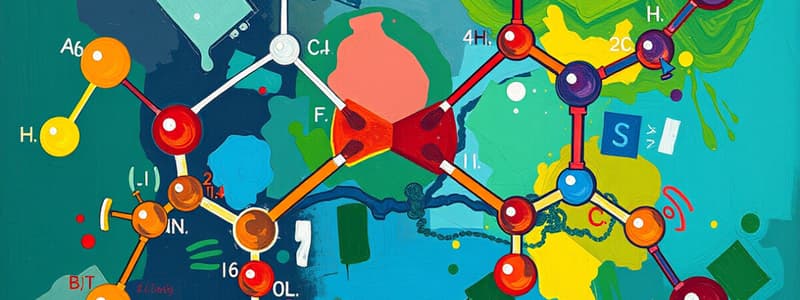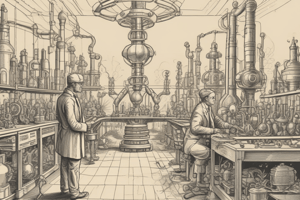Podcast
Questions and Answers
What is the oxidizing agent that converts alkenes to epoxides?
What is the oxidizing agent that converts alkenes to epoxides?
peroxybenzoic acid
Provide the major organic product of the reaction below.
Provide the major organic product of the reaction below.
Draw the major organic product generated in the reaction below, paying particular attention to regio- and stereochemical detail.
Draw the major organic product generated in the reaction below, paying particular attention to regio- and stereochemical detail.
Draw the major organic product(s) generated in the reaction below, paying particular attention to regio- and stereochemical detail.
Draw the major organic product(s) generated in the reaction below, paying particular attention to regio- and stereochemical detail.
Treatment of cyclopentene with peroxybenzoic acid results in which of the following? A) oxidative cleavage of the ring to produce an acyclic compound B) yields a meso epoxide C) yields an equimolar mixture of enantiomeric epoxides D) gives the same product as treatment of cyclopentene with OsO4 E) none of the above
Treatment of cyclopentene with peroxybenzoic acid results in which of the following? A) oxidative cleavage of the ring to produce an acyclic compound B) yields a meso epoxide C) yields an equimolar mixture of enantiomeric epoxides D) gives the same product as treatment of cyclopentene with OsO4 E) none of the above
Which of the following steps would successfully complete the following reaction? A) I only B) II & III C) I & IV D) I, II, & IV
Which of the following steps would successfully complete the following reaction? A) I only B) II & III C) I & IV D) I, II, & IV
Provide the major organic product of the reaction below.
Provide the major organic product of the reaction below.
Provide the reagents necessary to complete the following transformation. A) 1.BH3∙THF 2.H2O2, HO- B) H2O, H2SO4 C) OsO4, H2O2 D) CH3CO3H E) 1.CH3CO3H 2.H+, H2O
Provide the reagents necessary to complete the following transformation. A) 1.BH3∙THF 2.H2O2, HO- B) H2O, H2SO4 C) OsO4, H2O2 D) CH3CO3H E) 1.CH3CO3H 2.H+, H2O
Provide the structure of the major organic product of the reaction below.
Provide the structure of the major organic product of the reaction below.
Draw the major organic product generated in the reaction below, paying particular attention to regio- and stereochemical detail.
Draw the major organic product generated in the reaction below, paying particular attention to regio- and stereochemical detail.
Draw the major organic product generated in the reaction below, paying particular attention to regio- and stereochemical detail.
Draw the major organic product generated in the reaction below, paying particular attention to regio- and stereochemical detail.
Provide a detailed, step-by-step mechanism for the reaction shown below.
Provide a detailed, step-by-step mechanism for the reaction shown below.
A reaction of an unknown alkene with MCPBA in dichloromethane followed by work-up with H2O/H+ yielded a racemic mixture of (2S, 3S) and (2R, 3R)-3-methylpentan-2,3-diol. What is the specific structure of the alkene used in the reaction? A) (Z)-3-methylpent-2-ene B) (E)-3-methylpent-2-ene C) 2-methylpent-2-ene D) 2,3-dimethylbut-2-ene E) none of the above
A reaction of an unknown alkene with MCPBA in dichloromethane followed by work-up with H2O/H+ yielded a racemic mixture of (2S, 3S) and (2R, 3R)-3-methylpentan-2,3-diol. What is the specific structure of the alkene used in the reaction? A) (Z)-3-methylpent-2-ene B) (E)-3-methylpent-2-ene C) 2-methylpent-2-ene D) 2,3-dimethylbut-2-ene E) none of the above
Provide the structure of the major organic product of the reaction below.
Provide the structure of the major organic product of the reaction below.
Draw the major organic product generated in the reaction below. Pay particular attention to regio- and stereochemical detail.
Draw the major organic product generated in the reaction below. Pay particular attention to regio- and stereochemical detail.
What function does the peroxide serve when HBr is added to an alkene?
What function does the peroxide serve when HBr is added to an alkene?
Name the major product which results when HBr is added to 3-ethyl-3-hexene.
Name the major product which results when HBr is added to 3-ethyl-3-hexene.
Based on the relative stabilities of the intermediates involved, explain the basis for Markovnikov's rule in the addition of hydrogen halides to alkenes.
Based on the relative stabilities of the intermediates involved, explain the basis for Markovnikov's rule in the addition of hydrogen halides to alkenes.
Explain the regioselectivity observed in the radical addition of HBr to 2-methylpropene.
Explain the regioselectivity observed in the radical addition of HBr to 2-methylpropene.
The mechanism for the acid-catalyzed hydration of alkenes is simply the reverse of the mechanism by which alcohols are dehydrated using concentrated acid. This is an illustration of ________.
The mechanism for the acid-catalyzed hydration of alkenes is simply the reverse of the mechanism by which alcohols are dehydrated using concentrated acid. This is an illustration of ________.
What is the major product of the following reaction?
What is the major product of the following reaction?
Which of the following intermediates is thought to occur in the mechanism by which alkenes are hydrated in the presence of acid?
Which of the following intermediates is thought to occur in the mechanism by which alkenes are hydrated in the presence of acid?
When an alkene is subjected to treatment with Hg(OAc)2 in alcohol followed by reaction with NaBH4, what new class of compound is formed?
When an alkene is subjected to treatment with Hg(OAc)2 in alcohol followed by reaction with NaBH4, what new class of compound is formed?
Which of the following additions to alkenes occur(s) specifically in an anti fashion?
Which of the following additions to alkenes occur(s) specifically in an anti fashion?
What synthetic goal is achieved by subjecting an alkene to an oxymercuration-demercuration sequence?
What synthetic goal is achieved by subjecting an alkene to an oxymercuration-demercuration sequence?
Both (E)- and (Z)-hex-3-ene can be subjected to a hydroboration-oxidation sequence. How are the products from these two reactions related to each other?
Both (E)- and (Z)-hex-3-ene can be subjected to a hydroboration-oxidation sequence. How are the products from these two reactions related to each other?
When 0.25 mol of humulene is hydrogenated in the presence of a platinum catalyst, what is the molecular formula of humulene?
When 0.25 mol of humulene is hydrogenated in the presence of a platinum catalyst, what is the molecular formula of humulene?
________ is the use of an optically active reagent or catalyst to convert an optically inactive starting material into an optically active product.
________ is the use of an optically active reagent or catalyst to convert an optically inactive starting material into an optically active product.
Which of the following alkenes will yield a meso dihalide when reacted with Br2/CCl4 at room temperature?
Which of the following alkenes will yield a meso dihalide when reacted with Br2/CCl4 at room temperature?
Flashcards are hidden until you start studying
Study Notes
Organic Reactions and Mechanisms
- Focus on determining the major organic products of various reactions involving alkenes, taking into account regio- and stereochemical details.
- Peroxides function as radical chain initiators in the addition of HBr to alkenes, enabling anti-Markovnikov addition.
Key Reactions Overview
- The addition of HBr to alkenes can produce unique products based on the structure of the alkene, such as 3-bromo-3-ethylhexane from 3-ethyl-3-hexene.
- Understanding reactive intermediates, especially carbocations, is essential for predicting outcomes; the more stable carbocation forms govern reaction rates.
Reaction Mechanisms
- Oxymercuration-demercuration prevents skeletal rearrangement while achieving Markovnikov addition of water, distinguishing it from other hydration methods.
- Acid-catalyzed hydration mechanisms illustrate microscopic reversibility, indicating hydration and dehydration are linked processes.
Hydroboration-Oxidation and Anti-Markovnikov Addition
- Hydroboration-oxidation and treatment with gaseous HBr with peroxides yield anti-Markovnikov products.
- The distinction between (E)- and (Z)-isomers highlights how stereochemistry can lead to different product distributions.
Stereochemistry in Products
- Reactions with bromine typically result in anti addition, yielding meso products, particularly when reacting with symmetric alkenes like cyclopentene.
- The relationship between the products of (E) and (Z)-isomers can vary based on reaction conditions and mechanisms.
Synthetic Techniques and Reagents
- A variety of reagents are used for transformations, such as BH3∙THF for hydroboration or concentrated acids for dehydration.
- Peroxybenzoic acid (PhCO3H) is a notable oxidizing agent utilized to convert alkenes to epoxides.
Miscellaneous Concepts
- Asymmetric induction refers to using optically active reagents to create chiral products from achiral precursors.
- Structural diversity in organic products relies considerably on the specifics of reaction mechanisms and the conditions applied.
Application of Knowledge
- Students should work through detailed reaction mechanisms to reinforce understanding, especially noting how changes in conditions or reactants can affect regioselectivity and product outcomes.
- Recognizing how to navigate synthesis problems using logical progression through reaction pathways is critical for mastering organic chemistry concepts.### Reaction Mechanisms
- The reactions investigated require drawing major organic products, emphasizing regio- and stereochemical details.
- Understanding the mechanistic steps is crucial for predicting product formation in organic reactions.
Reactions Involving Alkenes
- The reaction of an unknown alkene with MCPBA (m-chloroperoxybenzoic acid) leads to the formation of a diol upon work-up with H2O/H+.
- The product obtained is a racemic mixture of (2S, 3S) and (2R, 3R)-3-methylpentan-2,3-diol, indicating a symmetrical reaction pathway.
Identifying Alkene Structures
- The specific structure of the alkene participating in the reaction can be inferred from the stability and symmetry of the resulting racemic product.
- Among the options provided, (Z)-3-methylpent-2-ene is identified as the correct alkene leading to the observed major product.
Stereochemistry Context
- Regioselectivity refers to the preference of a reaction to yield one structural isomer over others.
- Stereochemistry involves the spatial arrangement of atoms within a molecule, crucial for understanding reaction outcomes and product characteristics.
Studying That Suits You
Use AI to generate personalized quizzes and flashcards to suit your learning preferences.




